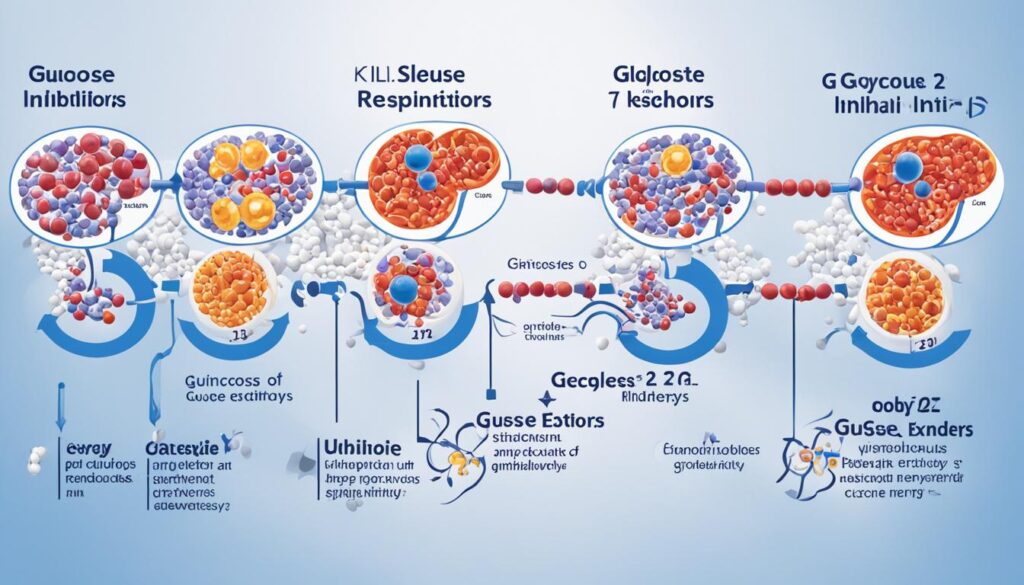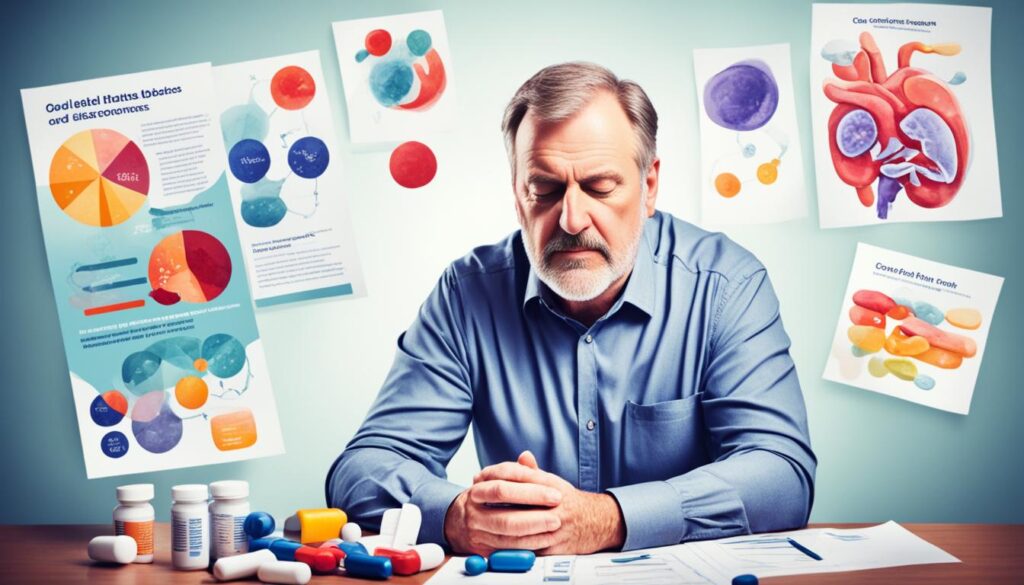Are you finding it hard to keep your blood sugar levels in check? Have you been given oral diabetes medications but don’t get how they work? Learning about these sugar defenders could help you manage your blood sugar better and take charge of your diabetes management1.
People with Type 2 diabetes and prediabetes often use oral diabetes medications. These drugs are key in controlling blood sugar levels1. They help by lowering blood glucose and fighting insulin resistance, a big factor in Type 2 diabetes1.
While lifestyle changes like eating right and exercising are crucial, oral medications can also be part of the plan1. Sometimes, doctors might suggest taking more than one oral diabetes medication to keep blood sugar levels in check1.
Knowing how these sugar defenders work can help you work better with your healthcare team. It can lead to better blood sugar support and management of your diabetes1. So, let’s explore oral diabetes medications – they might be the key to better health1.

Key Takeaways
- Oral diabetes medications are mainly for managing blood sugar in Type 2 diabetes and prediabetes.
- The best way to handle Type 2 diabetes is through lifestyle changes, exercise, and medication.
- Doctors might prescribe more than one oral diabetes medication at once for better blood sugar control.
- Insulin is needed for Type 1 diabetes, and there’s no pill for it.
- Oral diabetes medications work to keep blood glucose at healthy levels.
Introduction to Oral Diabetes Medications
What are oral diabetes medications?
Oral diabetes medications are key for managing blood sugar levels in people with diabetes, especially those with Type 2 diabetes and prediabetes2. They are taken by mouth, unlike insulin, which is injected. This makes them a convenient and effective way to help the body make more insulin or use it better2.
These medications lower blood sugar levels in different ways. They are a vital part of treating diabetes2. They help people with diabetes control their blood sugar better, lowering the risk of diabetes-related problems.
There are many types of oral diabetes medications, from metformin to newer ones like DPP-4 inhibitors and SGLT2 inhibitors23. Knowing about these medications and how they work can help people make better choices for managing their diabetes.
Using oral diabetes medications with healthy habits like eating right and staying active can improve blood sugar control and overall health for people with diabetes243.
“Effective management of diabetes through a combination of oral medications, insulin, and lifestyle changes is crucial for maintaining optimal health and reducing the risk of long-term complications.”
Types of Oral Diabetes Medications
Oral diabetes medications are many and work in different ways to manage blood sugar levels5. They include alpha-glucosidase inhibitors that slow down starch and sugar breakdown. Biguanides make insulin work better, and bile acid sequestrants help lower cholesterol and slightly lower blood sugar5.
Other types include dopamine-2 agonists that fix the body’s internal clock to fight insulin resistance. DPP-4 inhibitors stop GLP-1 breakdown, a substance that lowers blood sugar5. Meglitinides make the pancreas release more insulin, and SGLT2 inhibitors help get rid of glucose through urine5.
Classification of Oral Diabetes Medications
Sulfonylureas and thiazolidinediones (TZDs) are also used to treat diabetes. Sulfonylureas boost insulin release, and TZDs make muscles and fat tissues more sensitive to insulin5. Each type of oral diabetes medication has its own way of managing blood sugar and type 2 diabetes symptoms.

“Metformin is considered the most commonly prescribed oral medication for type 2 diabetes.”6
Metformin is a top choice, but there are others like metformin with alogliptin, glyburide, or pioglitazone6. GLP-1 receptor agonists and DPP-4 inhibitors are also key for better blood sugar control6.
There’s a wide variety of oral diabetes medications, giving doctors many options for each patient’s needs5. Knowing how these medications work is key to managing diabetes well.
Metformin: The First-Line Treatment
Metformin is a common type 2 diabetes treatment, often the first choice7. It helps by stopping the liver from making too much glucose and making the body more sensitive to insulin8. Being well-studied and trusted, it’s a top pick for doctors treating type 2 diabetes7. Plus, it’s safe for pregnant women with diabetes7.
Studies show metformin greatly helps manage type 2 diabetes8. A 1998 study in the Lancet found it cut down on complications in overweight type 2 diabetes patients8. Another review in 2017 showed it lowered death rates from all causes and heart disease in those with coronary artery disease8.
Metformin is also known for lowering heart disease risk8. A 2011 analysis found it helped prevent heart events and death8. A 2016 study in the New England Journal of Medicine showed it worked well with another drug for type 2 diabetes patients8.
Even with strong evidence, metformin faces challenges9. A 2014 JAMA study pointed out the need for careful monitoring in patients with kidney disease8. A 2002 Annals of Internal Medicine study also stressed the importance of ongoing research and updates in diabetes care with metformin8.
Sugar Defender – Blood Sugar Support
In summary, metformin is the go-to oral treatment for type 2 diabetes because of its proven effectiveness, safety, and heart health benefits7. Doctors often start with metformin for new type 2 diabetes patients, making it a key part of managing this condition7.
Diabetes medications: Sulfonylureas and Meglitinides
Sulfonylureas and meglitinides are key types of diabetes pills10. They help the pancreas make more insulin11. These drugs can lower blood sugar levels but may cause low blood sugar as a side effect11.
Meglitinides, like nateglinide and repaglinide, also boost insulin release but work faster10. They are taken before meals10. While they help control blood sugar, they can also lead to low blood sugar11.
| Medication Class | Compounds | Dose Range | Cost |
|---|---|---|---|
| Sulfonylureas | Glyburide, Glipizide, Glimepiride, Gliclazide | 2.5mg to 20mg bid | Low to High |
| Meglitinides | Repaglinide, Nateglinide | 0.5mg to 120mg tid with meals | Varies |
Sulfonylureas and meglitinides are good choices for type 2 diabetes. But, it’s crucial for patients to work with their doctors to find the right medication and dose for them.
“Sulfonylureas and meglitinides are often used as initial or add-on therapy for patients with type 2 diabetes who require additional glycemic control.”
Thiazolidinediones (TZDs) and Their Role
How TZDs Work in Diabetes Management
Thiazolidinediones (TZDs) are oral medications for type 2 diabetes12. They help by making the body respond better to insulin from the pancreas12. This means they can lower blood sugar levels effectively12.
Doctors give TZDs to adults over 18 with type 2 diabetes12. They might be used alone or with other diabetes drugs12. But, people with heart failure, bladder cancer, or liver diseases might not take them12.
TZDs can cause weight gain, more infections, and swelling12. They might also raise the risk of bladder cancer and bone breaks12. When taken with insulin, they can increase the chance of low blood sugar12.
It’s key to talk to doctors before starting TZD treatment12. Patients should tell their doctors about any side effects12. They should use reporting systems like the Yellow Card Scheme in the UK12.

“Thiazolidinediones are a valuable tool in the management of type 2 diabetes, but their use requires careful consideration of potential risks and benefits for each individual patient.”
DPP-4 Inhibitors: Enhancing Insulin Production
Diabetes management has seen big steps forward with DPP-4 inhibitors, or gliptins. These drugs help increase insulin production. This is key for keeping blood sugar levels in check for people with type 2 diabetes13.
DPP-4 inhibitors stop the breakdown of GLP-1, a natural body compound that lowers blood glucose when it’s too high14. By blocking the DPP-4 enzyme, these drugs let GLP-1 stay active longer. This leads to more insulin production and better blood sugar control14.
Sugar Defender – Blood Sugar Support
There are several DPP-4 inhibitors out there. Alogliptin (Nesina), linagliptin (Tradjenta), saxagliptin (Onglyza), and sitagliptin (Januvia) are some examples. Studies show they boost insulin production without causing weight gain or low blood sugar when used alone13.
Many clinical studies have shown that DPP-4 inhibitors work well with insulin for type 2 diabetes. They improve blood sugar control, cut down on severe low blood sugar, and help with weight management13.
Unlike GLP-1 receptor agonists, DPP-4 inhibitors don’t increase the risk of thyroid cancer or pancreatitis14. Also, while some drugs may lower heart disease risk, DPP-4 inhibitors don’t have this effect14.
The way DPP-4 inhibitors work and their safety make them a great choice for managing type 2 diabetes. They’re especially useful with insulin therapy to boost insulin production and better control blood sugar levels.

SGLT2 Inhibitors: A Novel Approach
A new type of oral medication called SGLT2 inhibitors is changing how we manage diabetes. These drugs stop the kidneys from reabsorbing glucose, letting it be passed out in urine15. This helps control blood sugar levels and can lead to weight loss and lower blood pressure15.
In the U.S., SGLT2 inhibitors like canagliflozin (Invokana), dapagliflozin (Farxiga), empagliflozin (Jardiance), and ertugliflozin (Steglatro) are approved15. Studies show they work well, especially empagliflozin, which lowers HbA1c, weight, and blood pressure15. It also cuts the risk of heart-related death by 38% in people with diabetes and heart disease16.
These drugs are mostly safe but may cause yeast infections in the genital area16. Still, their benefits make them a key part of treating diabetes for doctors and patients.
| Metric | SGLT2 Inhibitor Impact |
|---|---|
| HbA1c Reduction | 0.4-1.1% reduction16 |
| Weight Loss | 1.80-2.66 kg decrease16 |
| Blood Pressure | Systolic BP decrease of 3.4-5.4 mmHg, Diastolic BP decrease of 1.5-2.2 mmHg16 |
| Cardiovascular Outcomes | 38% reduction in cardiovascular death with empagliflozin16, 14% reduction in major adverse cardiovascular events with canagliflozin16 |
| Renal Benefits | 12.7% reduction in incident or worsening nephropathy with empagliflozin16 |
| Side Effects | Increased risk of genital mycotic infections, modest increase in urinary tract infections16 |
SGLT2 inhibitors offer a new way to manage diabetes, improving blood sugar, weight, and heart health151716. As we learn more about diabetes, these drugs are becoming a key part of diabetes care.

GLP-1 Receptor Agonists and Combination Therapy
GLP-1 receptor agonists are injectable medicines that act like the natural GLP-1 hormone in our bodies. They help control blood sugar levels and can help with weight loss18.
In the U.S., approved GLP-1 receptor agonists include dulaglutide (Trulicity), exenatide (Byetta, Bydureon), liraglutide (Victoza), lixisenatide (Adlyxin), and semaglutide (Ozempic, Rybelsus)18. Semaglutide and high-dose liraglutide are also approved for weight loss18.
The Role of GLP-1 Receptor Agonists
Doctors often use a mix of diabetes medicines to manage blood sugar better. Studies show that adding GLP-1 receptor agonists to other treatments can improve blood sugar, weight, and other health markers more than one medicine alone19.
But, these benefits may not last forever, and the risk of low blood sugar and side effects like diarrhea and nausea goes up19.
| Outcome Measure | Combination Therapy vs. Monotherapy |
|---|---|
| Glycated Hemoglobin (HbA1c) | Greater reduction with combination therapy19 |
| Body Weight | Greater reduction with combination therapy19 |
| Fasting Plasma Glucose (FPG) | Greater reduction with combination therapy19 |
| 2-hour Postprandial Glucose (2h PG) | Greater reduction with combination therapy19 |
| Systolic Blood Pressure (SBP) | Greater reduction with combination therapy19 |
| Body Mass Index (BMI) | Greater reduction with combination therapy19 |
| Low-Density Lipoprotein Cholesterol (LDL-C) | Greater reduction with combination therapy19 |
Combining treatments can lead to better health outcomes but also increases the risk of low blood sugar and side effects19.

“Combining GLP-1 receptor agonists with other diabetes medicines can help manage blood sugar and weight better. But, it’s important to know the risks involved.”
Side Effects and Precautions
Managing diabetes often involves taking oral medications. These drugs are key but can have side effects20. Common side effects include stomach issues like pain, nausea, bloating, and diarrhea20. Some drugs, like sulfonylureas and meglitinides, can cause low blood sugar (hypoglycemia)20.
Other side effects include weight gain, liver problems, skin rashes, and heart issues20. Some medications, like SGLT2 inhibitors, may increase genital and urinary tract infections20. Always talk to your doctor about possible side effects and safety tips when starting a new diabetes drug.
Sugar Defender – Blood Sugar Support
The risk and severity of side effects depend on the drug, dosage, and the patient21. For example, metformin can cause nausea, gas, diarrhea, and vitamin B12 deficiency21. Sulfonylureas may cause low blood sugar, weight gain, and skin rashes21.
Watch for any bad reactions and tell your doctor right away. Following your doctor’s advice and sticking to your medication plan can lower the risk of side effects. This ensures the safe and effective use of oral diabetes medications.

“Patients should always discuss the potential side effects and precautions with their healthcare provider when starting any new diabetes medication.”
Lifestyle Modifications and Monitoring
Managing type 2 diabetes is more than just taking pills. Eating right and exercising regularly are key to keeping blood sugar in check and avoiding problems22. People with type 2 diabetes need to check their blood sugar often and keep getting treatment to keep it at the right level22.
Exercise is great for managing type 2 diabetes, even if you don’t lose weight, by lowering blood sugar22. Adults should try to get at least 150 minutes of moderate exercise each week. Also, doing strength exercises 2 to 3 times a week is good23. It’s important to drink plenty of water and check your blood sugar before, during, and after working out, especially if you’re on diabetes meds23.
Eating well is also crucial for managing type 2 diabetes. Keeping an eye on what you eat, how much, and the carbs can help keep your blood sugar stable. Checking in with your doctor regularly and making changes to your diet or meds as needed is key22.
By making these lifestyle changes and using your meds correctly, you can greatly improve your health and lower the risk of diabetes problems24. Working with your healthcare team, you can create a plan that fits your needs and goals.

| Lifestyle Factor | Recommendation |
|---|---|
| Physical Activity | At least 150 minutes per week of moderate aerobic activity 2-3 times a week of strength-building exercise Monitor blood sugar before, during, and after exercise Stay hydrated |
| Diet | Consume a healthy, balanced diet Monitor food intake, portion sizes, and carbohydrate intake |
| Medication Management | Take prescribed medications as directed Adjust medication as needed based on healthcare provider recommendations |
By following these lifestyle changes and keeping up with regular checks, people with type 2 diabetes can manage their condition well and lower the risk of complications222324.
Conclusion
Oral diabetes medications are key in managing blood sugar control for those with type 2 diabetes management. They help by making more insulin, making insulin work better, and slowing down how the body absorbs sugar25.
Even though changing your lifestyle is the best way to manage diabetes, these pills can help too. They work together with healthy habits to keep blood sugar control in check. It’s important for patients to talk with their doctors to find the right pill or mix of pills for them25.
Some pills, like SGLT-2 inhibitors and GLP-1 receptor agonists, have been shown to lower the risk of heart problems, kidney disease, and death in people with type 2 diabetes management26. These can be especially helpful for people with heart or kidney issues26.
Sugar Defender – Blood Sugar Support
“Sugar Defender: The Most Affordable and Effective Solution for All Diabetes Issues”
Sugar Defender is a great option for people dealing with Sugar Defender conclusion and metabolic health issues. It uses natural ingredients to fix blood sugar problems by making insulin work better, stopping sugar from being absorbed, and helping the pancreas1718. This supplement doesn’t just control blood sugar. It also boosts overall metabolic health, offering a natural and budget-friendly way to get healthier and live better.
Sugar Defender combines ingredients like Eleuthero, Coleus, and Maca Root to fight diabetes and metabolic disorders. Studies show these natural ingredients help control blood sugar, make insulin work better, and support metabolic health18. With solid science and positive feedback, Sugar Defender is a summary solution for those looking for a natural way to manage diabetes.
Sugar Defender tackles the worldwide diabetes problem with a natural and affordable solution. It helps people take charge of their health by focusing on metabolic wellness. This supplement lets people feel more energetic, live better, and lessen the health and economic effects of diabetes1718. Sugar Defender is a key tool for managing and preventing diabetes-related issues.
FAQ
What are oral diabetes medications?
Oral diabetes medications are pills taken to help control blood sugar levels. They are for people with diabetes who still make some insulin. This includes those with Type 2 diabetes and prediabetes.
How do oral diabetes medications work?
These medications help lower blood sugar in different ways. They can make the pancreas produce more insulin. They can also make insulin work better and stop glucose from being absorbed too quickly.
What are the different classes of oral diabetes medications?
There are many types of oral diabetes medications. They include alpha-glucosidase inhibitors, biguanides, and others. Each type works differently to help manage blood sugar levels.
What is the most common oral diabetes medication?
Metformin is the most common oral diabetes medication. It’s often the first choice for Type 2 diabetes because it’s effective and safe.
What are the potential side effects of oral diabetes medications?
Oral diabetes medications can cause side effects like stomach problems and low blood sugar. They can also increase the risk of genital yeast infections. Always talk to your doctor about any concerns.
How important are lifestyle changes for managing diabetes?
Making healthy lifestyle choices is crucial for managing diabetes. This includes eating well and exercising regularly. Using medications correctly, along with these lifestyle changes, helps keep diabetes under control.
Source Links
- Diabetes & Oral Medication: Types & How They Work – https://my.clevelandclinic.org/health/articles/12070-oral-diabetes-medications
- What Are My Options for Type 2 Diabetes Medications? – https://diabetes.org/health-wellness/medication/oral-other-injectable-diabetes-medications
- Oral Medicines for Diabetes – familydoctor.org – https://familydoctor.org/oral-medicines-for-diabetes/
- Insulin, Medicines, & Other Diabetes Treatments – NIDDK – https://www.niddk.nih.gov/health-information/diabetes/overview/insulin-medicines-treatments
- Oral Medications for Type 2 Diabetes – https://www.webmd.com/diabetes/oral-medicine-pills-treat-diabetes
- List of Common Diabetes Medications – https://www.healthline.com/health/diabetes/medications-list
- First-Line Therapy in T2D: Has Metformin Been ‘Dethroned’? – https://www.medscape.com/viewarticle/995230
- Should metformin remain the first-line therapy for treatment of type 2 diabetes? – https://www.ncbi.nlm.nih.gov/pmc/articles/PMC7809522/
- Choosing First-Line Therapy for Management of Type 2 Diabetes – https://www.aafp.org/pubs/afp/issues/2008/0101/p16.html
- Oral and Injectable (Non-Insulin) Pharmacological Agents for the Treatment of Type 2 Diabetes – Endotext – https://www.ncbi.nlm.nih.gov/books/NBK279141/
- Medication for Type 2 Diabetes – https://nyulangone.org/conditions/type-2-diabetes/treatments/medication-for-type-2-diabetes
- Thiazolidinediones (glitazones) – https://www.diabetes.org.uk/guide-to-diabetes/managing-your-diabetes/treating-your-diabetes/tablets-and-medication/thiazolidinediones-glitazones
- Safety and Efficacy of DPP4 Inhibitor and Basal Insulin in Type 2 Diabetes: An Updated Review and Challenging Clinical Scenarios – https://www.ncbi.nlm.nih.gov/pmc/articles/PMC6167285/
- Frontiers | DPP-4 inhibitors for treating T2DM – hype or hope? an analysis based on the current literature – https://www.frontiersin.org/journals/molecular-biosciences/articles/10.3389/fmolb.2023.1130625/full
- Empagliflozin (Jardiance): A Novel SGLT2 Inhibitor for the Treatment of Type-2 Diabetes – https://www.ncbi.nlm.nih.gov/pmc/articles/PMC4450666/
- Use of SGLT2 inhibitors in type 2 diabetes: weighing the risks and benefits – Diabetologia – https://link.springer.com/article/10.1007/s00125-018-4663-6
- Novel Therapies in Diabetes: A Comprehensive Narrative Review of GLP-1 Receptor Agonists, SGLT2 Inhibitors, and Beyond – https://www.ncbi.nlm.nih.gov/pmc/articles/PMC10811430/
- GLP-1 Agonists – https://my.clevelandclinic.org/health/treatments/13901-glp-1-agonists
- The Efficacy and Safety of the Combination Therapy With GLP-1 Receptor Agonists and SGLT-2 Inhibitors in Type 2 Diabetes Mellitus: A Systematic Review and Meta-analysis – https://www.ncbi.nlm.nih.gov/pmc/articles/PMC8854770/
- Side Effects of Diabetes Medication | London Diabetes Centre – https://londondiabetes.com/news-and-events/common-side-effects-of-diabetes-medication/
- Do I Need to Change My Type 2 Diabetes Medication? – https://www.webmd.com/diabetes/change-type-2-diabetes-meds
- Patient education: Type 2 diabetes: Treatment (Beyond the Basics) – https://www.uptodate.com/contents/type-2-diabetes-treatment-beyond-the-basics/print
- Diabetes management: How lifestyle, daily routine affect blood sugar – https://www.mayoclinic.org/diseases-conditions/diabetes/in-depth/diabetes-management/art-20047963
- Living Healthy with Diabetes – https://www.heart.org/en/health-topics/diabetes/prevention–treatment-of-diabetes/living-healthy-with-diabetes
- Comparative Effectiveness and Safety of Medications for Type 2 Diabetes: An Update Including New Drugs and 2-Drug Combinations – https://www.ncbi.nlm.nih.gov/pmc/articles/PMC3733115/
- Benefits and harms of drug treatment for type 2 diabetes: systematic review and network meta-analysis of randomised controlled trials – https://www.bmj.com/content/381/bmj-2022-074068